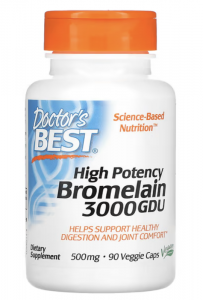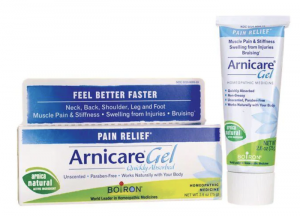What is Normal (and Not Normal)
After Plastic Surgery
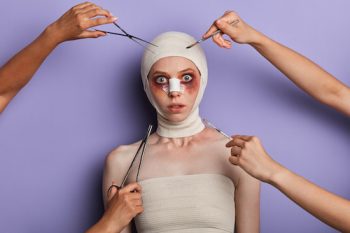
Heading Home From Surgery
So, you got your plastic surgery and you are headed home or to your recovery house with post-op instructions in-hand. You are told to let your doctor know immediately if you have warning signs after plastic surgery
(the things that are not normal) such as:
- Signs of an infection like pus, hot skin, and a fever
- Blood Clots – characterized by pain, redness, and swelling (usually in the legs). They often appear suddenly. This is an emergency and you should go to the ER right then.
- Tissue Necrosis (dying tissue) – tissue turning black (not bruising)
- Weird Smells Coming from Your Incisions
- Extreme Swelling – yeah, this one is a bit hard to define as people swell to different degrees. The range of normal is fairly broad.
Above and beyond that, very little information is given about what you can expect to experience on a day-to-day basis and what is considered “normal” during recovery.
It would be better if surgeons would inform you about this stuff ahead of time, but the truth is that there is so much to tell you that they don’t have time. Once in a blue moon it will be written down in your post op instructions.
Surgeons rarely get involved in the nitty gritty of post-operative recovery. They are trained to benchmark your progress at certain intervals to see if you are having any abnormal developments at that stage of your recovery – and this is good, but it is not enough.
Just checking to see if your incision is closing as it should and that you don’t show signs of infection falls far short of what people really need to know as they heal.
What to a surgeon is simply an everyday situation at the office (seeing people who look like they got hit by a bus) is quite different to their patients. It can be terrifying to many people to see their bodies bruised, distorted, painful, and swollen. Of course, people are told to expect it, but it is a different story when you wake up from anesthesia and live that experience of pain, swelling, and bruising.
What people experience from one day to the next after plastic surgery includes all kinds of aches, pains, swelling, and the like. Most of it is all completely normal, but if you have never been through it, how do you know what is “normal”?
This is Not Medical Advice!
Before I continue, I want to emphasize that the information in this blog post should not be taken as medical advice.
You should always consult your doctor if you have a concern.
That being said, there are so many very common annoyances that happen after plastic surgery, which are completely normal yet send people in recovery into extreme anxiety, that I thought I’d write this post to help explain the normal plastic surgery recovery experience in detail. I also mention some supplements commonly taken after surgery. These are not recommendations but rather a reporting on what is commonly used.
You should consult your doctor before taking any supplements following surgery. Surgeons often have strong opinions one way or the other about taking supplements post op. It is important to ask them if they are ok with you using supplements. They need to know the “big picture” in what you are doing during your recovery in order to advise you well.
The First Few Days
The first few days after plastic surgery are the worst, bar none.
(Almost everyone has a really hard time in the first 3 days.)
If you read this article in the first few days of your recovery, hang in there. This time is pretty rough, but it gets better. I promise. Your feelings of regret are normal, and they will pass.
If you are past the first few days, congratulations! You have made it past the worst part, but your journey is still just getting started, and there is a lot you need to know. Keep reading.
Pain
Some pain is normal at this time. It usually begins as the drugs you were given for your surgery start to wear off.
Plastic surgeons often dispense a few days worth of pain medication to help you deal with the discomfort, although many people find that they do not need it. Others decide that they would rather forego the pain meds due to the fact that they often worsen the constipation that follows surgery.
If you do choose to take your pain meds, be sure to eat something (preferably bland) before taking them, as they can upset your stomach, just making you feel worse.
Looking Like Crap
You have undoubtedly seen the numerous Instagram images of people right after surgery where you see what a nice contour they have. Usually these photos are taken by the docs right after they finish – BEFORE the swelling sets in.
By the time that you come out from under anesthesia and are able to conceive of the idea of taking a selfie, your body has had ample time to swell. The result is that you are going to look like hell. You wanted to look like the image below on the right, but you look much more like the image on the left. Hang in there. This is normal. It will pass.
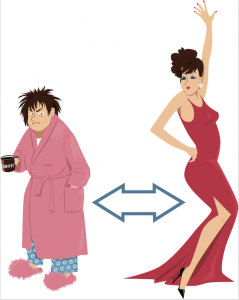
Remember that surgery is a type of trauma (like a car accident). You wouldn’t expect to wake up in the hospital after a car accident looking like a supermodel. The same thing applies here.
This is completely NORMAL. Have patience. You won’t see your final results for quite some time. As many people say on social media – trust the process.
Buyer’s Remorse
Buyer’s remorse – especially in the first few days is very common. “What the #*<& did I do to my body?!?!?” goes through everyone’s mind. This passes after a few days for most people. It is normal to continue to wonder if you will come out looking right, since the swelling makes it difficult to see.
Nausea
Nausea is a common side effect of anesthesia.

Ask for medication as soon as you notice it. If you let it get bad before you ask for meds, it’s harder to get it under control.
Constipation
Constipation after surgery is completely normal, albeit quite uncomfortable.
The cause of constipation is the delayed effects of anesthesia which paralyzes the gut.
Many people are prescribed stool softeners by their physician, or they take magnesium supplement like Calm (Amazon ad link) to get their gut moving afterwards. Magnesium pulls water into the intestine. Calm comes in powder and gummy (Amazon ad link) form.
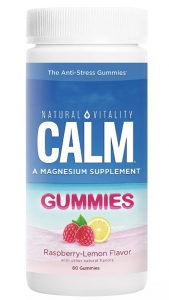
Water is your friend here. The gut doesn’t move well if you are dehydrated, so drink up. It does help – especially if you choose to take a magnesium supplement. Contrary to what many people think, drinking water does not cause swelling. It actually helps prevent it.
Sore, Itchy Throat and Cough
It is normal to have a sore, scratchy throat after surgery, because it is common to be intubated for surgery. When you are intubated, your surgical team places a breathing tube down your throat. It remains in place for the duration of your surgery which can be several hours. The insertion, removal, and the fact that it is simply there next to the delicate tissues in the windpipe cause irritation.
Be prepared with some throat lozenges or numbing spray such as Chloraseptic spray (Amazon ad link).
By numbing your throat, you can help prevent coughing. This is definitely something you want to do if you had a tummy tuck!
Bruising & Swelling
Bruising and swelling are part of the normal recovery process.
In the days that follow your surgery you will likely have bruises that can be quite dark. In most people the bruises clear up in a week or two (everyone is different).
Bromelain and topical (not ingested) arnica (Amazon Ad) are commonly used to help speed up healing from bruising.
Bromelain is an enzyme derived from pineapple. Many people opt to consume pineapple juice or canned pineapple after surgery, but it is usually pasteurized which destroys the bromelain. It is better to obtain bromelain from either fresh pineapple or from a bromelain supplement (Amazon ad).
For some other helpful supplements after plastic surgery, click here.
Genital Swelling
If you landed here because your nether regions are hugely swollen and grossly discolored, please stop panicking.
Your surgeon didn’t do anything inappropriate to you while you were asleep. This is a fairly common thing to happen after tummy tucks and liposuction of the abdomen.
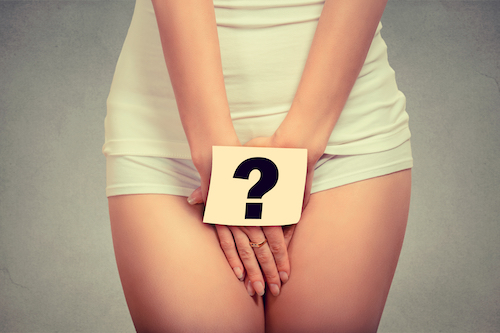
In short, fluid heads “south,” and it carries with it any excess blood from tiny blood vessels that were cut during surgery. Both the swelling and the discoloration look awful, but they are normal.
To learn more about this topic, and what you can do to fix it at home, check out this post:
Is Genital Swelling Normal After Plastic Surgery?
In The Weeks That Follow Surgery
After you get over the first few days following surgery, there are still several things that crop up in the following weeks as you heal. Remember, recovery is a process, not an event. It is filled with ups and downs – and this is totally normal.
Swelling
Once the unsightly bruises start to fade, the swelling remains for a while. Lymphatic massage helps with this tremendously, but it is still normal to have days when you are less swollen and days where you feel like a balloon.
“So, why,” might you ask, “should I pay for lymphatic massage if I am just going to swell back up again?”
That is a totally fair question, so let’s address it.
When you come for a lymphatic massage after plastic surgery, you are working to get rid of swelling that happens as a result of the inflammation process. This fluid is full of waste products and dead cells after your surgery. The body’s cleanup process really takes quite a while.
Then, you go home and you swell again. It’s frustrating, but it is normal, expected, and good (despite not feeling good). The swelling that comes isn’t just annoying fluid. The body is delivering much needed nutrients to the cells that are still alive in the surgical area. They desperately need nutrition to rejuvenate themselves in order to divide and make more new cells in order to patch up the damaged area.
Additionally, there are numerous other specialized proteins and repair molecules that are being delivered to the area. It is necessary in order to heal. To see how this process works, I recommend watching this short animated video I made on how the lymphatic system works.
If you find that for some reason you can’t get a lymphatic massage as soon as you need after surgery, I’ve made a video here to help you do your own massages.
Skin Peeling
Peeling skin following cosmetic surgery is a common occurrence, and is generally nothing to worry about. Peeling, flaking, or unusual dryness happens due to a couple of factors.
In order for skin to be nice and supple and moist, it must be fed (nourished) from the blood vessels underneath. When the surgeon does lipo or a tummy tuck, or other procedure that damages these blood vessels, then the skin is deprived of food. This causes it to die at a more rapid rate than normal. (Skin normally dies as it rises closer to the surface. I’m not talking about skin necrosis where the blood supply is completely cut off from a garment that is too tight and causes the skin to turn black. That is an emergency.)
Localized skin peeling/flaking is also caused by the swelling (edema) present in the area of surgery. In order for cells to effectively receive nutrition from the nearby blood vessels, they can only be a few cell’s width away (roughly 2-4 cells). When swelling is present, it pushes the cells further away from the blood vessels making it difficult for nutrients to reach the cell. Combine that with lots of damaged blood vessels discussed earlier, and you have a recipe for skin that isn’t going to be getting all it needs until the damaged vessels regrow and the swelling has gone down.
It is for these reasons that you should not be put into a faja that is too restrictive too early (not before 7-10 days minimum). (FYI: You will be wearing that faja for a couple of months.) Dry skin in the surgical area is a normal, visible sign that ideal conditions below the surface do not yet exist.
Dry skin on the whole body is generally an indication of dehydration. Drink plenty of water – it doesn’t increase swelling – and consider a humidifier if you are in a dry climate.
Lumps and Bumps
As annoying (and distressing) as they may be, lumps and bumps are par for the course in post-op recovery. They can be particularly noticeable after lipo of the thighs, upper arms, and chin. The other place that they commonly occur is on the sides around the waist. They can technically occur anywhere, however.
If you are in recovery and you notice a few bumps, don’t stress about it too much. Yes, they should be addressed, but they are normal. To read more about what causes them and what to do about them, check out my other article on Lumps and Bumps After Plastic Surgery here.
Itching, Burning, Shocking, Stabbing
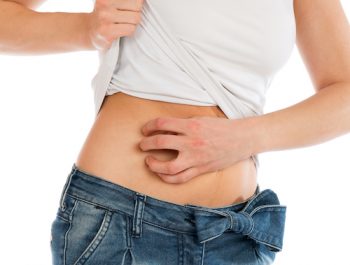
Another “fun” part of plastic surgery is nerve regrowth. This is especially true with liposuction, but happens to some degree with any plastic surgery.
You are going along, minding your own business when suddenly you feel like someone zapped you with a mild taser in the side. Normal? Yep.
These zaps, zings, and itching are signs that your nerves are regenerating and that you will be getting your feeling back.
Getting Sick When Touching Numb Skin
It is normal as well to get sick to your stomach when you touch an area of your body where you don’t yet have sensation.
There is a disconnect in your brain that it trying to reconcile. Your fingers have normal sensation, but your skin in the surgical area does not. It is a puzzle that the brain doesn’t know how to solve that causes the feelings of icky-ness.
A good tip here is to try putting on a pair of gloves that remove some sensation from your fingers when you touch a numb area. The brain sometimes accepts this a little better.
Lopsidedness – One Side Bigger Than The Other
This is a super common thing to have happen after surgery, and while, yes, it can be that you truly are not symmetrical, the most likely explanation is that you are unequally swollen.

The lymphatic system doesn’t drain 100% equally on the right and the left. There are traffic jams along the pathways that can cause less drainage on one side vs another. This is totally normal and generally resolves as your swelling goes down with lymphatic massage.


